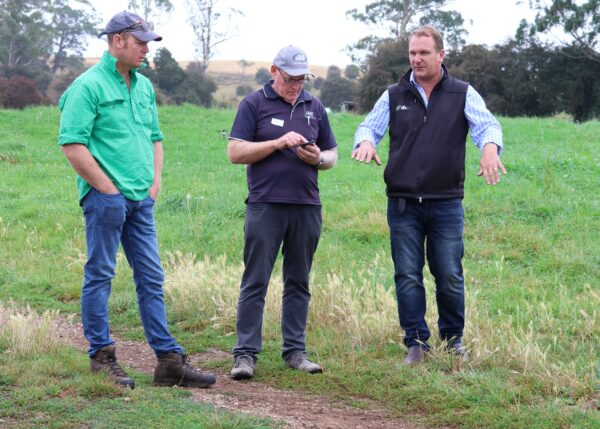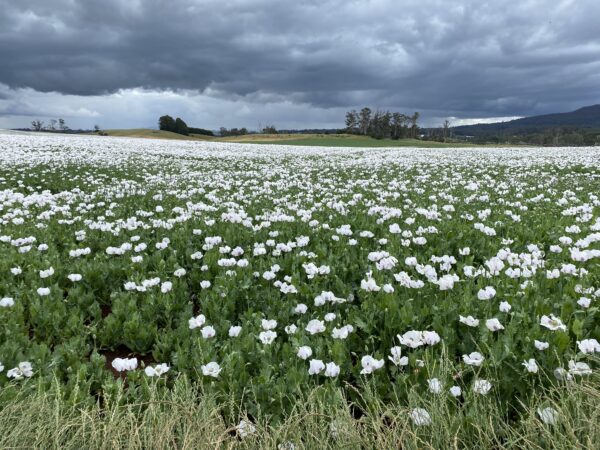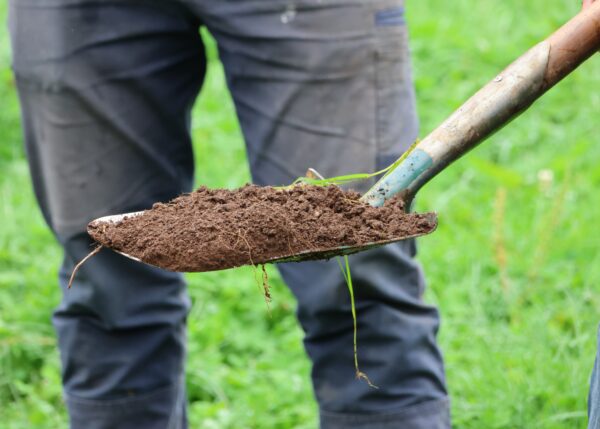While Mark Wadley’s move away from synthetic Nitrogen saved him some cash…a decade later the money has nothing to do with why he has embraced biological farming so completely.
Mark and Josephine Wadley milk 360 cows (with 1100 cattle all up) on their Meander Valley farm at Deloraine, in Tasmania. They own 486 hectares (1200 acres), which includes cropping country. The farm is a mix of free-draining red soil (ideal for cereal crops) and heavy flat land (good grazing country).
When they turned to biological farming there were few working Australian examples, so they became part of a pioneering group that formed the foundation which would give others the confidence to follow.
“I remember when I first started considering it in 2013, I worked it out that that I was going to save $30,000 to $40,000 on conventional fertiliser costs that year, and that was another reason to give it a go at the time.” Mark said.
“I thought if I don’t like it, I’ll go back to what it was doing. But I just never turned around.”

Mark Wadley initiated biological farming because he wanted sustainability. He stayed because the health of his farm and cows has improved so much.
Practical triggers drove change
His other reasons for switching before it was popular – came down to some forward thinking around the global industry’s Nitrogen addiction.
“It was about sustainability for me, to be honest,” he said. “I felt like it was going to eventually be policed more. It’s happening in New Zealand now, but it’s been happening in Europe for a long time, hasn’t it? To me, it just made sense for our soil and our animal health, and I thought I may as well get ahead of the game.”
Then, there were the practical triggers. His Somatic Cell Count (SCC) at the time was sitting around 200,000 and wouldn’t budge, and his empty rates had climbed to 17%.
“I pretty well just jumped in boots and all because I figured…nothing ventured, nothing gained,” Mark said.
“I guess, you’ve got to put a certain amount of trust in the process. To me, it was daunting in that there weren’t many people that we could go to at that time and look at their farms and see how it had worked over a 10-year period.
“Farmers considering it now do have that advantage.”

Mark Wadley (left) is joined by Hugh McMullan (centre), and Dan Huggins (right)
Both feet in the water
At the time, he put his faith in Dan Huggins, of Maxi Cow Consulting.
Dan said Mark’s starting point is more common than many realise. The difference was Mark was prepared to change things.
“This journey is the culmination of 14 years of trial and tribulation, in collaboration between myself, Ange Angelino (AAC consulting) and Hugo McMullan (Animal Mineral Solutions) – collectively the Dairy Business Centre Australia,” Dan said.
They also had access to US-born biodynamic specialist Hugh Lovel (who was semi-retired in New South Wales).
“We were blessed to have access to Hugh throughout a lot of this development period. Sadly, he passed away in the spring of 2020, before he could see the full impact of this work,” Dan said.
“But one of his comments that still resonates with me was that we wouldn’t see the full benefits until our clients were milking females that were third generation bred, born, and raised on these pastures.
“Mark is now milking those third-generation females, and we’re really starting to see a completely different milking cow. I believe their longevity will now far exceed Mark’s traditional averages.”
Mark confirmed his herd health has been supported by the math. His average SCC recently hit 50,000, his empty rates have been down as low as 11%, and his herd is averaging 600kg of Milk Solids.

Mark Wadley (left) hosted a tour of New Zealanders in March who wanted to see the results of his switch to biological farming. John Guy, from Te Waiu Limited, was keen to dig deeper.
PASTURES RESPONDING
He said the pasture changes came fairly quickly.
“I treated my dairy platform biologically from the get-go, but the dryland and cropping areas were still treated conventionally for perhaps another three or four years.
“However, once I could see how well the biological programme was working, I knew that I needed to do it across the rest of the farm as well.
“We could see the difference in the quality of the grass pretty fast. The clovers returned, and really responded in those pastures, as opposed to the pastures that were still under conventional fertiliser. The fungi in the soil – because we were watching that too – was also starting to happen.
“The whole philosophy started to make more and more sense to me as I started seeing how it was working. Since this time, I’ve had some incredible results with my seed potato and poppy crops too.”
Four and five-leaf clovers everywhere
He applies the biological fertiliser through his centre pivot irrigator in the summer. They use a broom spray unit converted with boomless jets to apply it through the rest of the year.
While he was an early adopter, Mark was a quick study.
“I guess, you’ve got to put a certain amount of trust in the process. To me, it was daunting in that there weren’t many people that we could go to at that time and look at their farms and see how it had worked over a 10-year period. Farmers considering it now do have that advantage.
“But, in saying that, the results didn’t shock me. It was more interesting than anything, I guess. There is a lot of phosphorus in the soil, but it gets tied up, becomes inaccessible to the plants, and the soil tests really showed how that worked. You need the biology in there working to unlock it.”
Mark was interested – like many of his fellow biological farming counterparts – to see the enormous number of four and five-leaf clovers returning to their pastures.
“Dan said we’d start to see more and more of them. And, it’s now common to see them all the time. I think it has also had an impact on the pasture palatability because you can see that the cows graze the paddocks out better, and more evenly. It has been fascinating to watch all the positive changes.”
Dan explains why, “Once you change the system to a minimal reliance on Nitrogen the biology in the soil flourishes and you grow pastures, crops, and food in general with far higher nutrition. When you have more mineral uptake in plants it increases the complexity of carbohydrates and amino acids (or building blocks of proteins). Building that fertility grows nutrient-dense pasture that is far higher in natural sugars, so our cows logically become more contented.
“Once that plant sugar content moves above a certain level the plant sap also becomes too complex for simple sucking pests, which traditionally plague pasture production. So, what traditionally sounded like a ‘too good to be true’ story has been proven to be right, and I no longer have to talk about pest and disease in my consulting discussions with Mark.”

Mark and Josephine’s poppy crop had two sprays of soil drench. Photo: Dan Huggins.
The surprises?
“I feel like the soil moisture retention is better, which I can’t quantify because it changes from season-to-season anyway, doesn’t it?
“But when we’re irrigating, I don’t feeling like I’m having to chase my tail so much. Again, if you’re building your humus and your soil carbon, your soil is holding on to its moisture better anyway.”
Today, Mark is probably including roughly 40-45 units of Nitrogen within his annual biological framework.
“Which is well below the current caps in New Zealand. When Nitrogen regulations come to us – and they will – I won’t have to worry. I feel like I’m ahead of the game in that sense.”
Mark’s SCC is averaging around 120,000 with lows down to 50,000.
“It definitely dropped when we started farming biologically, so once again, was it a surprise? Or, was it just another reassuring thing to make us feel that, ‘yes, we’re on the right track’. Because the SCC is just another indicator of cow health. Those numbers gave us confidence that we’re doing the right thing.
“I suppose what does surprise me is that people want to come to the farm to have a look, because it just feels normal to us now.”

Isaac Korpershoek says their soil feels lighter and is visually crumblier when they dig into it now.
So many reasons to adopt
He says biological farming is no more work than conventional. He sleeps soundly at night, knowing he is setting his farm up for the generations to come, while looking after his cows’ health right now.
He said, “I don’t even factor the annual savings in anymore, because there are so many other reasons that make you feel like you’re doing the right thing with biological farming.”

The New Zealand farmers were equally impressed by Isaac and Angelique Korpershoek’s decision to follow biological farming as they were by the couple’s aggressive succession plan that allowed them to step up to farm ownership.







